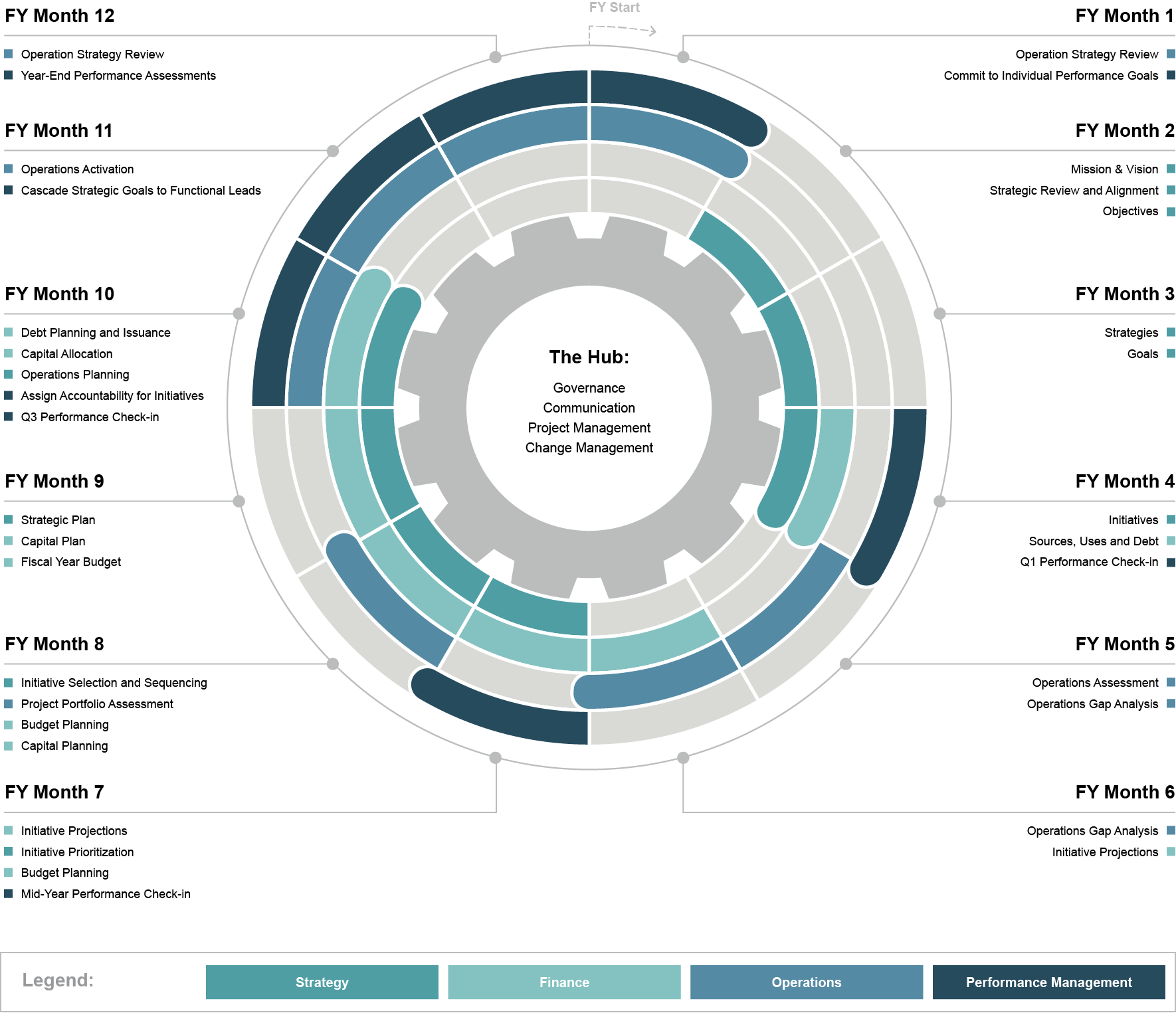In April 2022, we shared why historic operating models struggle to serve the future of healthcare. In that article, we posited that health system operating models have not evolved with the same innovation and efficiency as the medical care they deliver. Instead, they have become clunky and bureaucratic, adding layers and hierarchy without adding value to patients, communities, and other stakeholders.
We proposed a more Active Operating Model—one that can anticipate and respond to changes in the market with agility, courage, and resolve. We use this framework to help organizations understand and invest in the “Hub” of their operating models—those infrastructural functions that choreograph operations, strategy, and team collaboration and create a flywheel effect. In this article, we explore a few of those essential investments.

Elements of the Hub include:
| Governance | Communication | Change Management | Project Management |
|---|---|---|---|
| Organization Structure | Internal Plan | Culture & Resiliency | Dependencies |
| Accountabilities & Decision Rights | Community Plan | Change Readiness | Measures of Success |
| Committee Structure | External Marketing | Transformational Agility | Tracking Tools |
Govern With Clarity
"We have an operating model ..."
Often, this statement precedes the presentation of an organizational chart. The chart is important as it shows reporting lines and management structures that offer a basic understanding of team players and hierarchy, but it will not:
- Promote consistency in job titles or scalability in the organization
- Outline key decision rights and promote appropriate levels of autonomy
- Clearly articulate expectations and how they are rewarded
These are critical to team dynamics and effective operations but do not happen by accident. A lack of clarity can lead to frustrating conundrums. Consider two very capable leaders:
- The administrator of an ambulatory surgery center responsible for the day-to-day operations and profitability of their facility
- A service line leader responsible for optimizing and growing orthopedics across all markets
The service line leader wants to capture greater market share by purchasing new equipment and hiring an additional surgeon. Once the capital budget is approved, the service line leader recruits an accomplished surgeon and gains approval for related operating expenses. The two leaders meet to discuss remodeling, staffing changes, new patient flow, and case-mix adjustments—all of which will impact two endoscopy suites that share patient waiting areas, registration staff, and sterilization equipment. How do you think this conversation goes?
It is likely that the administrator feels their autonomy and responsibilities have been undermined and unlikely that any disagreement will resolve itself without intervention from the C-suite. In theory, though, this should be resolved long before this situation arises. After all, these changes are aligned to strategy and budgeted for, but the lack of clarity around final decision making and accountabilities may result in unnecessary friction and conflict.
Deliberately designing your governance structure and documenting these decision rights and accountabilities is far from oppressive. Organizational clarity catalyzes quick decisions, healthy conflict resolution, and greater cooperation among teams toward shared goals. Sound business decisions can be made outside of the C-suite if the organization is appropriately designed and enabled.
Communicate With Purpose
Town halls, intranet pages, emails and blogs, and digital break room signage
These are tried-and-true mechanisms for general updates, but they are rarely effective in gathering feedback and ideas from employees, developing understanding and connection to strategic plans, or articulating more tactical organizational goals, accountabilities, and responsibilities.
It is important to leverage expertise and discipline in prioritizing and sequencing messaging, developing key speaking points, and translating concepts in ways that each employee can relate to and understand. Be prescriptive, deliberate, and rigorous in communications when:
- Communicating the Strategy – Front-line employees may loosely relate to high-level strategy, but they will connect meaningfully with specific goals and likely contribute directly to strategic initiatives. Let communications professionals translate strategy in ways that can help employees feel a stronger connection to mission, vision, and culture.
- Communicating Expectations – HR teams have long shouldered the burden of developing coaching and performance management guidelines, but the “why” of these expectations is equally important. Cascade goals in a way that helps employees make the connection between their individual contributions and the organization’s mission and success.
- Communicating Ideas – Leaders need to set the tone and decide on overarching goals and metrics for the year, but also share what the organization is trying to accomplish and solicit ideas on how to do so. Leverage mechanisms that can gather thoughts and feedback from employees, and reward those who contribute actionable ideas.
- Communicating the Brand – External and marketing plans have great influence over public and patient perception of value, can assert position in crowded markets, and convey positive experience and emotions. Often, community relations are vital to obtaining funding, building permits, and partnerships. Organizations can advance their missions with patients willing to share their stories in the market. Invest in campaigns like the best global brands to meet new and growing consumer expectations.
Build Your Change Agility
When your cup does not runneth over
Research consistently shows that employees who are healthy, resilient, engaged, and empowered in their work are more productive, creative, innovative, and loyal.1 In an era where turnover and burnout and the associated costs are sky rocketing, proactively building change agility and a strong and healthy culture are imperative to achieving strategic and operational goals.
Self-care experts proclaim “you can’t pour from an empty cup,” and certainly there is some truth to that. It is difficult to fund projects without a budget, but it also is difficult to ask employees to consistently take on more and more. Managing organizational bandwidth is financially prudent but also promotes the healthy culture and connection to organizational mission and strategy that are critical to achieving goals. We encourage organizations to:
- Measure and understand your people and organizational health. Our Clari³ty® services can help measure change agility and burnout so you can gather insights and intervene with intention.
- Set clear performance expectations and articulate what success looks like for different positions, roles, and levels. Hold individuals accountable to these expectations and reward them (or not) accordingly.
- Be rigorous in setting and managing the few key priorities to best utilize the time and talents of your people.
Curate a Focused Portfolio of Projects
Keep your eyes on the prize
When it comes to managing organizational bandwidth, project and change management teams should be strong allies, if not coexisting in the same teams, offices, or even roles. Far from task managers who produce stoplight dashboards, effective project management offices are invaluable in providing the rigor and discipline required to juggle operational imperatives and strategic initiatives while maintaining a healthy culture.
In the last several years, FORVIS has promoted a less static strategic planning cycle for our clients. We encourage you to evaluate your mission, vision, values, and strategic goals on a more traditional three- to five-year cycle, but brainstorm, budget, and implement initiatives that serve those goals on an annual basis. This allows the organization to be more proactive to market dynamics and industry trends, but requires significant discipline to gather ideas, prepare business cases, objectively prioritize, shepherd through the budgeting cycle, and then put together project plans and mobilize teams for implementation. Strong project management teams can coordinate these loose pieces and parts—lending vital tracking tools and prioritization mechanisms that help support the broader infrastructure of the Hub.
The Bottom Line: A Strong Infrastructure Supports Momentum
FORVIS has long maintained that the changes occurring in the healthcare industry demand that health system leaders take a proactive stance in setting strategy. As we watch leaders navigate strategy execution, the outmoded nature of historical operating models is evident. We created the Active Operating Model to provide a framework that rethinks organizational norms, aims to improve agility, and helps contribute to the vitality and sustainability of the healthcare industry. Clear and robust operating models help promote quick decision making, articulate performance accountabilities, and prioritization mechanisms that encourage healthy cultures and employee engagement. To help improve your operating model, invest in four imperatives:
- Govern with clarity
- Communicate with purpose
- Build your change agility
- Curate a focused portfolio of projects
For assistance in tackling your unique needs, please reach out to a professional at FORVIS.
- 1"10 Timely Statistics About the Connection Between Employee Engagement and Wellness," forbes.com, January 16, 2019.

